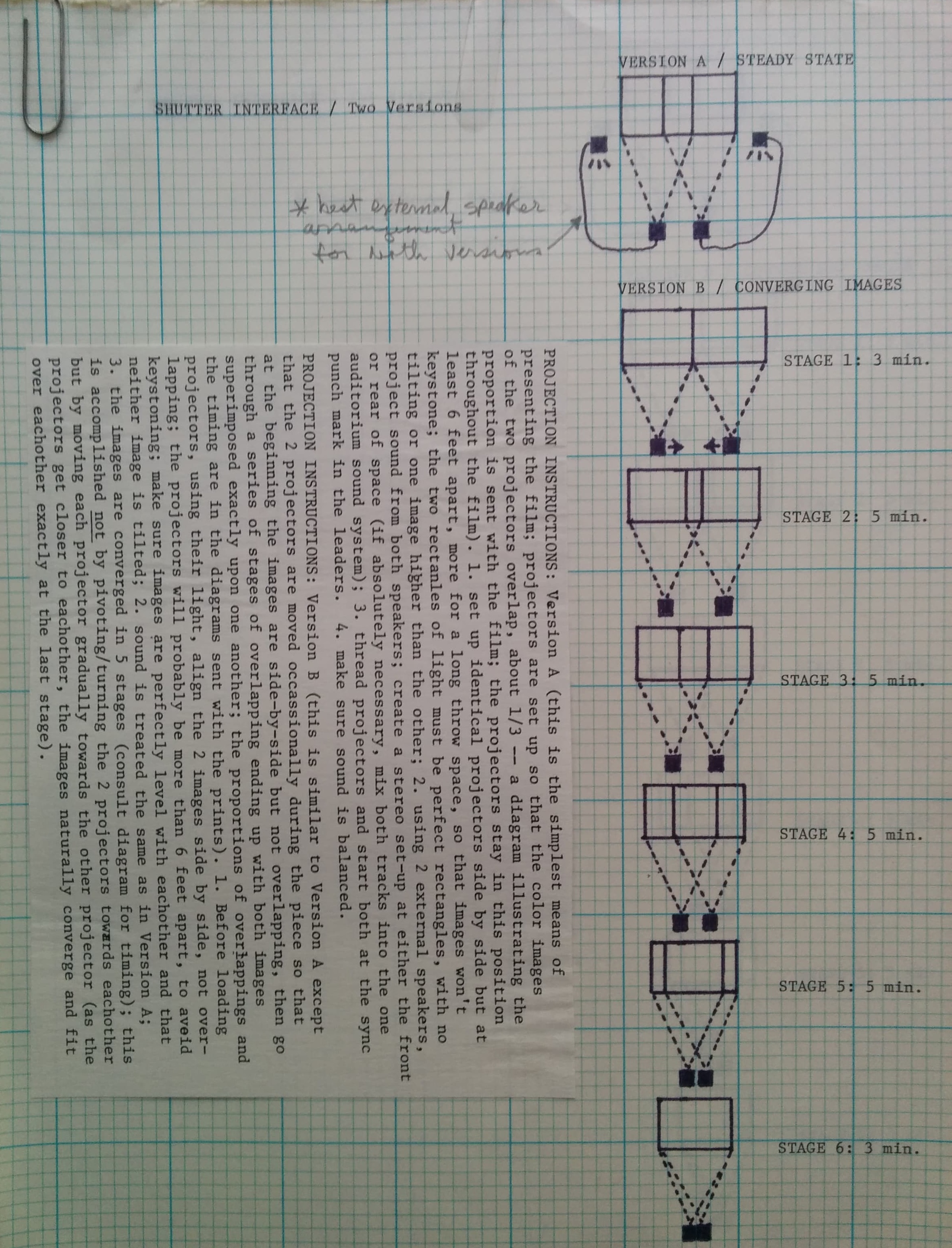Program 7
Sunday, March 17, 2019 @ 9 pm
The Lab (2948 16th Street, SF, CA)
Total running time: 57 minutes
$6 - 10 sliding scale - tickets available at the door
Festival passes available for purchase here
Rate of Change
Bill Brand
1972 | 18 minutes | USA | 16mm | color | sound
Acts of Light is a trilogy consisting of Rate of Change, Angular Momentum, and Circles of Confusion. Together they develop a study of pure color based on the notion that film is essentially change rather than motion. The films build one on the other as first pure change, then relational change, and finally, irrational change. They can be seen together or as separate works.
Rate of Change has no original, no frames, only slow continuously shifting colors, cycling around the perimeter of the spectrum. The changes are so slow as to be unseen, yet they alter perception of the color.
-BB
Shutter Interface
Paul Sharits
1975 | 25 minutes | USA | 16mm x 2 | color | sound
The central idea was to create a metaphor of the basic intermittency mechanism of cinema: the shutter. If one slows down a projector, one observes a "flicker"; this flickering reveals the rotating shutter activity of the system. Instead of slowing down a projector, one can metaphorically suggest the frame-by-frame structure of film (which is what necessitates a shutter blade mechanism) by differentiating each frame of the film by radical shifts in value or hue; this metaphor was a guiding principle in my work in the 1960's, in my so-called "color flicker films." I discovered, two years ago, that I could heighten this metaphor by partially overlapping two screens of related but different "flicker footage" and the conception of four overlapping screens began to evolve. For installation pieces, I prefer to use long film loops, each a slightly different length, so that the relationships within the system go through many phases, maintains the piece seem to be beyond duration, to exist as on-going environments of visual-aural activity (I regard them as "locations").
-PS
Cyclone Tracery
Richard Tuohy & Dianna Barrie
2018 | 15 minutes | Australia | 16mm x 2 | b&w | sound
On Christmas eve in 1974, the city of Darwin in tropical northern Australia was devastated by Cyclone Tracy. In this expanded cinema piece, a single film print, featuring only concentric circles is bi-packed against itself in two 16mm projectors simultaneously. Through this approach, the quadrupled image of circles is transformed into troubled patterns of pulsating and swirling interference and whaling sounds of tropical violence.
-RT & DB
Bill Brand is a multi-disciplinary artist whose films, public artwork, installations and works-on-paper have exhibited worldwide in museums, galleries microcinemas and on television. His 1980 Masstransiscope, an animated mural installed in the New York City subway, is in the MTA Arts and Design permanent collection.
Bill Brand’s artwork has been featured at Museum of Modern Art, Whitney Museum, Smithsonian American Art Museum, National Gallery of Art, Anthology Film Archive and Shanghai Duolun Museum of Modern Art. He is represented by Galerie Arnaud Lefebvre, Paris.
His films have been presented at major film festivals including the Berlin Film Festival, New Directors/ New Films Festival, Tribeca Film Festival and Rotterdam Film Festival.
Trained as a graphic artist and a painter, Paul Sharits became an avant-garde filmmaker noted for manipulating the film stock itself to create a variety of fascinating, abstract light and colorplays when projected on the screen. Fans hail the effects hallucinogenic, while his detractors find them garish. Sharits is also known for establishing experimental film groups at prominent universities, including one at the University of Indiana where he studied. He later taught and developed an undergraduate film program at Antioch College. Between 1973 and 1992, Sharits taught at the Center for Media Study at the State University of New York. His films can be seen in various U.S. and European museums, film centers, and libraries. Much of his work can be found in the Anthology Film Archives in New York City.
Richard Tuohy (b. 1969, Melbourne, Aus.) began making works on super 8 in the late nineteen eighties. Since 2009 he has been an active and vocal member of the international artist run film lab scene. In 2011 Richard and Dianna started the Artist Film Workshop which in 2012 became a membership based artist-run film lab, itself also part of the international labs network. An advocate for the possibilities of hand made cinema, Tuohy has devoted much time and effort in sharing his knowledge through workshops and classes both in his native Australia and internationally.
Dianna Barrie (b. 1972, Melbourne) found her way into filmmaking as a middle ground between the pursuit of abstract music and philosophy, both of which she has studied formally at the post graduate level. Ever pushing the limits of the hand processing of super 8 led to the establishment of nanolab withRichard Tuohy in 2006. Dianna's film work could perhaps be characterised as 'direct chemical' filmmaking. Works generally begin with some form of camera image capture. This is followed by interventions during hand processing and exacting editing and/or printing processes. Dianna has emerged as a noticeable figure in the international artist-run film labs movement. She and her partner spend a significant amount of time each year touring their joint film programs and conducting workshops and masterclasses in hand-made film practice.



